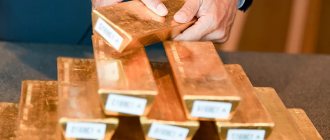What is the US gold reserve, where is it located and does it really exist? These questions concern both business people and politicians of various levels, as well as the average person, regardless of whether he stores money in foreign currency, is interested in binary options, or just sometimes plays on the exchange. After all, it was thanks to gold that the American dollar became the equivalent of a world currency.
The amount of gold in the United States is of great importance because it is one of the indices of the solvency and stability of the American currency.
Gold is still a measure of wealth, both personal and national. Today, according to official data (which, by the way, is not perceived unambiguously by everyone), America's gold reserves amount to 8133.46 tons of pure gold, which is equivalent to 72.2% of the volume that makes up the entire gold and foreign exchange reserve of this country, and makes it the leader in quantity gold reserves in the world.
Yellow Metal Vaults
Where is US gold stored? Depositories include the American Mint in Denver, where 1,400 tons of precious metal are stored, the West Point money yard, where 1,700 tons are believed to be stored, the Federal Reserve Bank's underground vaults several floors deep in Manhattan with 400 tons of bullion, and finally, the top-secret mysterious facility Fort -Knox, which allegedly stores 4603 tons of metal, i.e. most of the American gold supply. Fort Knox bullion is referred to as “gold bins,” and bullion deposited in other depositories is referred to in business filings as “other Treasury gold.”
The famous Fort Knox, named after the first Secretary of War Henry Knox, is located in the US state of Kentucky and is an impregnable fortress with a huge moat, where military security boats constantly cruise.
The building, which today belongs to the American army, was first built of granite and then covered with concrete for durability. Watchtowers are located at each corner of the site, surrounded by several rows of 5,000-volt barbed wire. Modern surveillance systems complement the security of the territory and monitor every meter of it. Even next to the 44,000 hectare site on which the building is located, parking is prohibited.
The entrance door to this depository, made of reinforced steel, weighs more than 20 tons and can withstand a bomb explosion or a direct hit from a shell. The clever system of the lock code involves dividing it into parts among several employees. Thus, each of them has only part of the cipher, and in order to open the door, all code keepers must take turns typing a combination of signs and symbols known only to them. The interior of the gray prison-like building is a bunker consisting of separate sections, each of which can be filled with poisonous gas or water at the right time.
The defense is completed by an autonomous life support system designed in case of attack, which includes various food supplies, water and electricity supplies. None of the ordinary citizens can get inside, literally only a few representatives of the legislative branch, and of the American presidents only Franklin Roosevelt and Harry Truman were here.
Leading gold mining companies in China.
China's top ten gold producers account for more than half of the country's total refined gold volume.
China National Gold Group Corporation (CNG).
China's largest gold mining conglomerate. CNG is owned by the Chinese state and reports directly to the central government. Notably, CNG is the only Chinese gold mining company that is a member of the World Gold Council (WGC). The companies included in the CNG group include the mining company, the group's international arm China Gold International Resources Corporation and nationwide jewelry chain Zhongjin Gold Jeweler.
Zhongjin Gold Company.
Headquartered in Beijing, it is the largest gold producer in China and holds the largest gold reserves of any Chinese mining company. Its largest mine is located in the Dazhuohan region and also controls gold mining resources in Shandong province and other areas of China. Zhongjin Gold shares are listed on the Shanghai Stock Exchange.
CNG Corporation owns 39% of China Gold International, which is listed on the Hong Kong and Toronto stock exchanges. China Gold International also controls 2 operating gold mines in China, one of which is the CSH open pit mine located in Inner Mongolia, and the other is the Jiama open pit mine and underground copper-gold and other minerals (base metal) mine located in the Tibet region. Together, these 2 gold mines have proven reserves of 5.1 million ounces of gold (159 tons) and measured resources of 8.5 million ounces (264 tons).
The subsidiary Zhongjin Gold Jewelery sells gold in approximately 1,600 jewelry stores throughout China. These outlets sell gold bars under the CNG brand as well as other gold investment products.
Shandong Gold Group.
A state-owned company controlled by the Shandong provincial government and named after the Shandong province in East China, which is located northwest of Shanghai. Shandong shares are listed on the Shanghai and Shenzhen stock markets.
Shandong is one of the largest gold mining groups in China. Shandong controls more than 1,000 tons of identified gold reserves on the Jiaodong Peninsula, one of the richest gold resource areas in China, and more than 1,400 tons of identified gold reserves overall.
Its four mines, each with gold reserves of more than 100 tons, are located on Sanshan Island, in the Jiaojia, Linglong and Xincheng districts of Shandong Province. Although the majority of the group's gold resources are located in Shandong, Shandong Gold also controls gold resources in other areas of China, as well as outside China. Shandong Gold recently discovered a huge new gold deposit, Xiling, near its gold mine on Sanshan Island. The Xiling gold deposit, which is still in the exploration stage, will eventually yield more than 550 tons of gold and become China's largest ever single gold deposit, Shandong said.
A little history
Fort Knox was built as a depository in 1936, and it was built urgently, because President Roosevelt, who was in power at that time, began to withdraw gold from circulation by buying it from the population. Most of the precious metal came from banks, which were provided with so-called “gold certificates” and credited to their balance sheets. All monetary reserves kept by citizens were taken away, with the exception of dental and jewelry. So much gold had accumulated that the US Mint in Philadelphia could not provide its maintenance and protection; the need arose for a new storage location, and the choice fell on the military camp of Fort Knox.
A train from Philadelphia delivered the first gold reserve to the Fort Knox base on January 13, 1937. The train consisted of 9 cars with precious metal melted into ingots, which was accompanied by armed soldiers, secret agents and US Mint guards. The train was greeted by thousands of officially invited persons and dozens of journalists. It all looked like a holiday show. Only starting with the next train, such trains began to be surrounded with secrecy and the dates of their arrival began to be hidden.
Zijin Mining Group.
Also one of the largest mining groups in China, it controls minerals including gold, copper, iron ore and other minerals. The group is engaged in exploration, development, mining and processing of mines and has more than 1,350 tons of underground gold reserves. Jijin's gold mines include the Zijinshan Gold & Copper Mine open-pit mine in Shanghai, which contains one of the largest gold deposits in China, the Liba open-pit gold mine in Gansu province, the Shanggong underground gold mine in Hunan province, and the Dongping gold mine in Hebei province.
The group also owns a 70% stake in the Yinhui gold refinery located in Hunan province. Zijin shares are listed on the Shanghai and Hong Kong stock exchanges.
Hunan Gold Corporation.
Headquartered in Huaihua in the southwestern Chinese province of Hunan, hence the name "Hunan". Formerly known as Chenzhou Mining Group, the group changed its name to Hunan Gold in 2015. Hunan is engaged in the exploration, mining, processing and smelting of non-ferrous metals, including gold. Gold bars produced by Hunan are produced under the Chenzhou brand.
What's in the bins?
Rumors that there is no gold in Fort Knox for a long time have been discussed for many years by financial, political and business circles around the world. At the same time, some interested parties believe that a significant share of the reserves was spent on paying for secret operations of the US State Department abroad.
Another part of the skeptics is inclined to believe that fake tungsten gold is stored in the underground halls of the impregnable fortress.
There is also a category of people who assume that the gold is there, but no longer belongs to the treasury, since it has been pledged and re-pledged many times.
Counterfeits in China
The version of counterfeits instead of genuine bars is supported by the story of Chinese gold that happened in 2009. Then a batch of gold from the Fort Knox vault in the amount of 5,600 bars of 400 ounces each was sent to China. Having received the bullion, the Chinese government wanted to check its purity and weight, issuing appropriate orders in this regard. And not in vain: all the bars turned out to be fake.
The fakes were made of tungsten coated with a thin layer of real gold.
Based on the markings on the counterfeits, the Chinese determined that they were cast in the 1990s. and were obtained from banks owned by the Fed while Bill Clinton was president. It turned out that, by order of Federal Reserve bankers, about 1.5 million tungsten tiles weighing 400 ounces were then produced, of which 640 thousand pieces were transferred to the Fort Knox vault, and the rest were sold on the international gold market.
After China reported receiving counterfeit bullion, one of the US congressmen demanded an audit of national depositories, but the Washington administration did not support it, which aroused reasonable suspicions among the world community.
Where is Germany's gold?
The situation with German gold that arose in 2014 is closer to the version that claims that this gold is no longer in the Fort Knox vault or in the basements of Manhattan. At first, American representatives, under various pretexts, delayed negotiations on the return of the German precious metal to their homeland, then, when the Germans tried to at least look at their gold in the American vault, they were not allowed to do so, and in the end, during a whole year of negotiations, only 5 tons of bars were transferred to the German side.
After this, Germany changed its mind about returning its gold reserves home, citing the fact that transporting such cargo would require too much expense, and it had no reason not to trust the United States. However, the doubts of skeptics were strengthened by the fact that the returned bars were not at all the same ones that the German side had once transferred to America for safekeeping. The tiles received from the Americans were cast quite recently and had a different marking, which means the ingots were substituted. It would be natural to assume that German gold had long been sold on Asian markets, and the Americans had to buy the metal again in order to partially satisfy German demands.
Volume of gold production in China.
Domestic gold mining is the second largest source of gold production in China after gold imports.
China's annual gold production far exceeds that of Australia and Russia, which rank second and third in the world in gold production. These two countries produced an average of 320 tons during 2021.
China's annual gold production has increased by 65% since 2007, first exceeding 300 tonnes in 2009 and then 420 tonnes in 2021. By 2021, gold production will reach a record 500 tons. This will mean that gold production will grow by an average of 3-5% per year during the period 2019-2022.
Chinese golden army.
The Chinese Armed Gold Police is a special unit tasked with the exploration of gold and other minerals throughout China, including gold geological prospecting, drilling and identifying priority areas for exploration. In a word, his main task is “to find gold for the country.”
Created by then-Chinese Premier Zhou Enlai in the late 1970s to identify gold reserves in China, the plan was implemented using engineering and construction teams of the Chinese Armed Forces (People's Liberation Army) to conduct the actual surveying, exploration and subsequent mining.
Since its inception, this Golden Army group has helped find more than 1,800 tons of gold in China.
Information about the Celestial Empire
News reports have reported that China has been actively buying gold since 2014. It ranks second in this area and works as if in tandem with Russia, which, despite sanctions and the crisis, is actively replenishing its gold reserves.
China has been buying gold for several years now, which provokes speculation about the presence of a strategy for the coming years. By sharply increasing gold prices, China could disrupt the global dominance of the dollar, making the yuan the world currency. Gold, which has fallen in price, can help preserve savings during the global crisis not only for individuals, but also for the entire state.
According to this state of affairs, the yuan can “overtake” the dollar and other world currencies and become the leading means of payment, more backed by gold reserves compared to the dollar. The plot of this plan lies in the events of 1971, when the dollar was no longer backed by gold. Since then, the United States has created many financial instruments, with the help of which it has expanded the scope of its currency, backing it up with the sale of oil and conducting all international currency transactions in it. The idea that the “petrodollar bubble” could burst and the dollar’s exchange rate could collapse haunts analysts and provokes opposition from countries such as China and Russia.
Current state of affairs
When China is actively buying gold, a fall in the stock market can occur at any time and lead to a global crisis. The reason China is buying gold is because of falling prices - since the beginning of 2015, gold prices have fallen by 15%. Gold is still a safe investment even when prices aren't rising. In 2015, both individuals and banks continue to buy gold because the precious metal is a good investment. Before gold prices rise, you should replenish your reserves. Active gold purchases by Russia and China could cause gold prices to rise sharply due to limited supplies. Deflation also causes the price of gold to rise. If the market falls, gold prices will rise sharply. In the event of hyperinflation, gold will retain its real value.
A new trend has also emerged at international auctions. Previously, brokers focused on the dollar-gold pair; when the dollar exchange rate rose, the price of gold fell and vice versa. Now this market strategy is no longer stereotypical and these two indicators are less dependent on each other. For a simple broker using Internet platforms, trading may become less profitable, since now basic knowledge of the system no longer provides the necessary amount of information. The processes taking place during the day of trading are already more difficult to track and only those who know a little more than others about the plans of states and large investors for buying and selling precious metal can win here.
Bretton Woods in Beijing
Apparently, China is hatching plans to change the global financial system, in which gold will play a key role. Something similar to the gold standard, which will allow the main geopolitical goal of the Celestial Empire to be achieved - moving away from the dollar payment system.
Interestingly, the classic gold standard will turn 200 years old next year. It was established by the Paris Conference of 1821. Having gone through many metamorphoses in its history, it was abolished in 1971 in the United States, which formally supported the gold parity of the dollar within the framework of the post-war Bretton Woods system.
The big question is: is China preparing to launch a gold currency? There is no answer at the moment. Since the 2008 crisis, there have been countless similar conversations. On the other hand, from a historical point of view, 10-12 years is not a long time at all. And if China continues to greedily buy gold assets, most likely this is part of some strategy that currently remains somewhere behind the scenes.
Apparently, the PRC expects that in the future gold will be used as a reserve asset, and it will be on it that the financial system that will replace the current one will be based.









